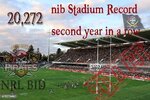This is not right. There are 90 AFL players based in Perth. About half from WA. Each year, maybe one or two players originally from the east want to return, but there might be one or two players playing in the east who want to return to WA. So it evens out and is not a factor.
A Perth NRL team would be successful off field in terms of crowds, etc, but whether that would lead to biggers ratings (maybe) or an increase in participation (maybe) is unknown. Melbourne has had only slight increases in that regard despite 23 years as one of the top clubs. But Perth only has two AFL clubs, Eagles by far the biggest. You play most home games the weekends that the Eagles are not playing. With a half decent team I reckon you would sell out 20K most weeks. Playing the first game of the season and any finals @ Optus Stadium you would have crowds averages in the top four.
If you actually want to grow participation and the talent pool, you need both a top down (NRL club) and bottom up (volunteer driven community based programs) approaches. That is where RL has struggled in Melbourne - there are limited opportunities for kids to try/play RL. E.g. there is not a RL club within 15 - 20kms of AAMI Park. You need hundreds of passionate volunteers, and/or tens of millions of dollars to grow grass roots footy in a new market. Unfortunately for RL in NSW & Qld, the AFL has both, and you could argue that the NRL has neither (outside of NSW/Qld).
So, it depends on what you are trying to achieve. If it is a national profile, more eyeballs, bigger TV deal, more money in the game and a chance to compete on level footing with AFL, then Perth, and possibly Adelaide to follow, are where you expand. If you are simply aiming to protect participation and grass roots, you take the safe option of Brisbane 3. But whilst this may lock in RL as easily the number one football code in NSW/Qld, it probably also locks in forever being the number two football code in Australia.
Team 18 must be Perth.

